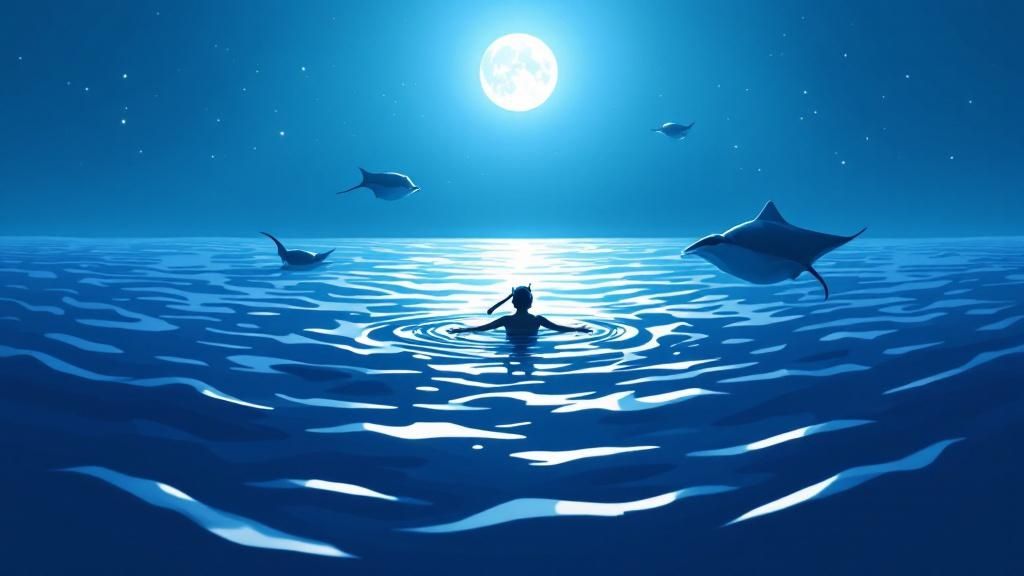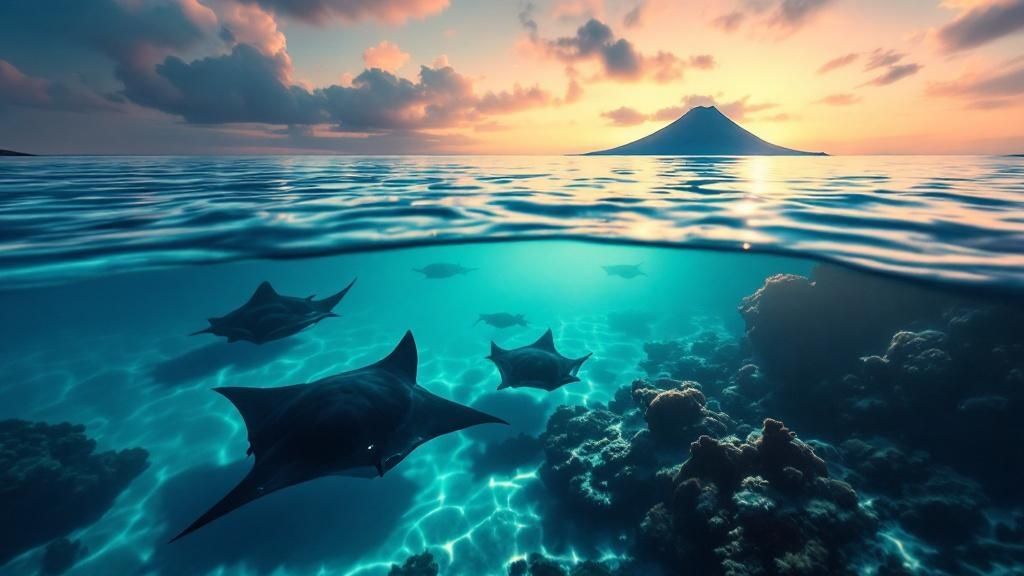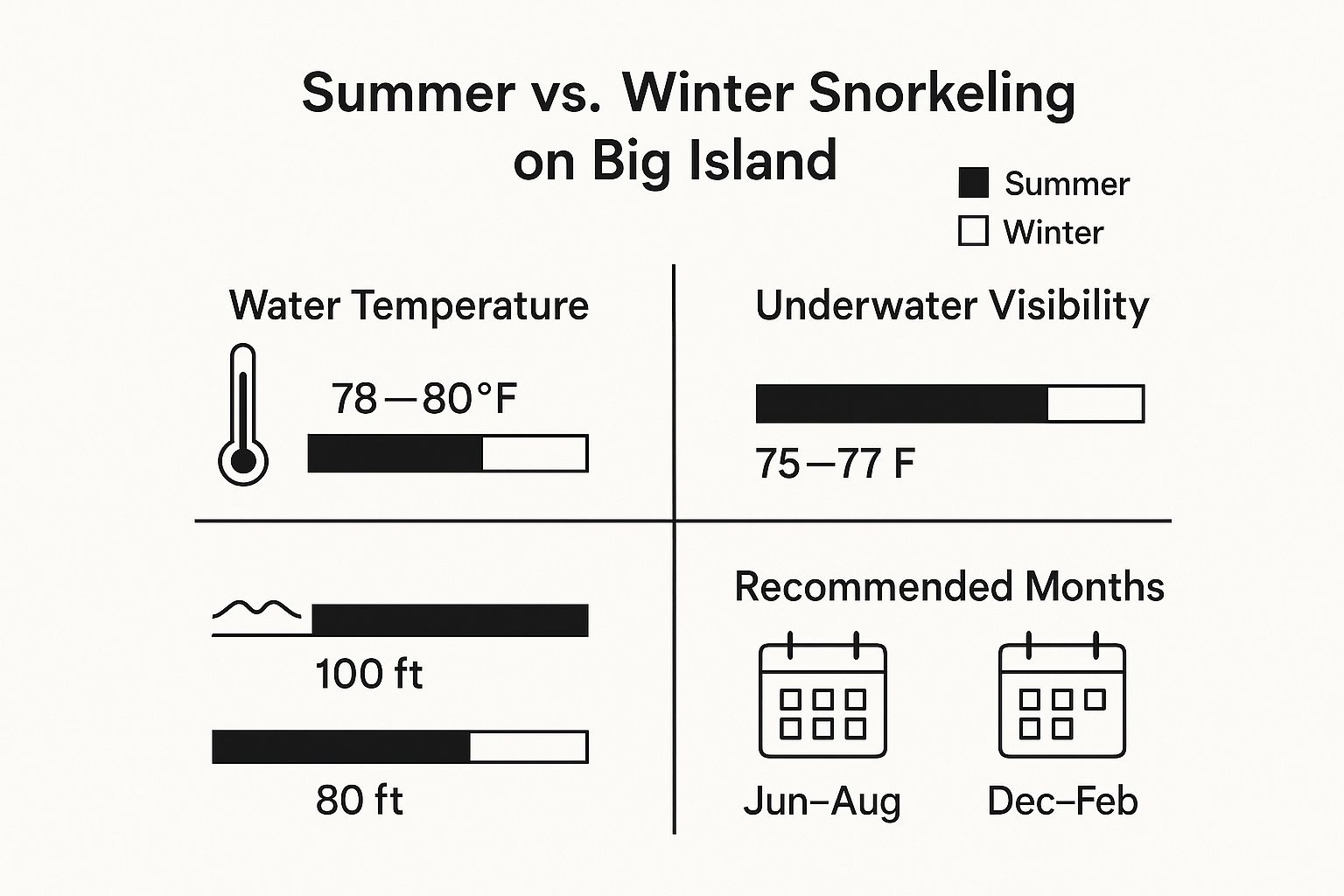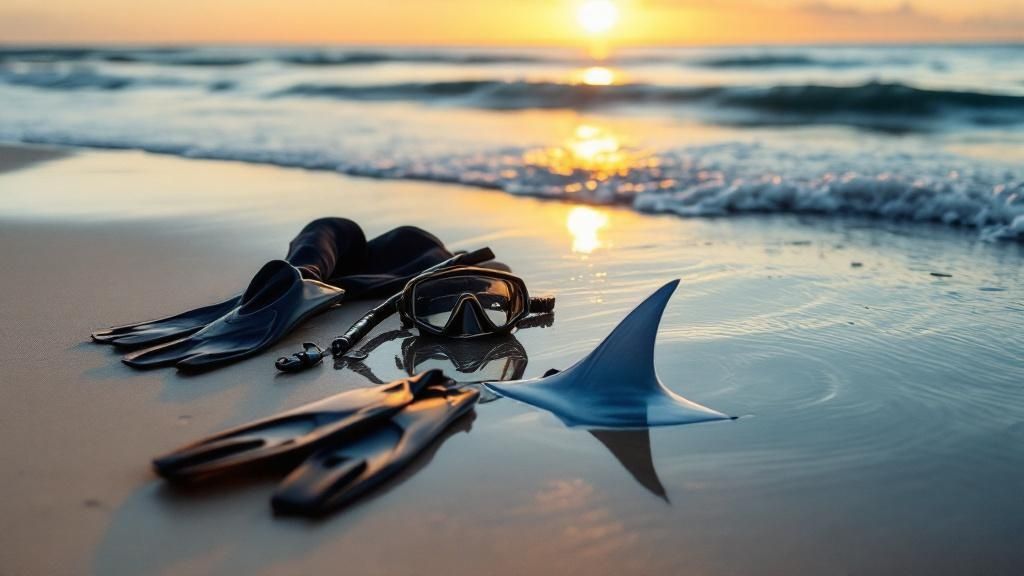Manta Ray Snorkel Big Island | Experience the Magic Now
- Byron
- Jul 4
- 15 min read
Picture this: you're floating in the warm, dark waters of the Pacific Ocean. Suddenly, a gentle giant with a wingspan wider than a car glides effortlessly just inches below you. This isn't a scene from a nature documentary—it's the very real, very magical experience of a manta ray snorkel on the Big Island. It’s consistently called one of the best nighttime water activities on Earth, and once you do it, you'll understand why.
Your Essential Big Island Manta Ray Snorkel Adventure

The Big Island of Hawai'i is home to one of the most reliable and awe-inspiring wildlife encounters you can find anywhere. Here’s how it works: after sunset, tour boats motor out to specific spots along the Kona coast, switch on powerful underwater lights, and simply wait.
These lights act like a massive bug zapper for the ocean, attracting huge, shimmering clouds of plankton—the favorite meal of manta rays.
What happens next is an underwater ballet that's nothing short of breathtaking. Drawn by the all-you-can-eat plankton buffet, majestic reef manta rays emerge from the darkness. They swoop, glide, and perform mesmerizing barrel rolls, often coming within inches of snorkelers holding onto floating light boards. It’s an incredibly close yet respectful way to see these gentle giants do their thing.
For a quick overview of what to expect, check out this handy table.
Big Island Manta Ray Snorkel Quick Guide
This table breaks down the key details you'll need for planning your manta ray adventure on the Big Island.
Aspect | Details |
|---|---|
Location | Primarily off the Kona Coast, Big Island, Hawaiʻi. |
Best Time | Year-round, with sighting success rates often above 80-90%. |
The Experience | Snorkelers float on the surface holding a light board while mantas feed below. |
What You'll See | Reef Manta Rays (Mobula alfredi) feeding on plankton. |
Safety | Tours are guided by professionals; manta rays are gentle and harmless. |
Booking | Advance booking is highly recommended, especially during peak season. |
This gives you the basics, but diving into the details is where the real magic is.
Why Is Kona Such A Manta Ray Hotspot?
It's no accident that Kona is a world-famous hotspot for manta ray encounters. The island's unique underwater geography, shaped by volcanic slopes, creates the perfect conditions. These slopes cause nutrient-rich water to well up from the deep, fueling a massive plankton population and basically setting a five-star dinner table for mantas every single night.
This reliable food source is why the experience is so consistent. At key sites like Manta Village and Manta Heaven, the sighting success rate is an incredible 80-90%. This dependability has made the manta ray snorkel Big Island tour an iconic and unforgettable part of any Hawaiian vacation.
To get an even better feel for the tour, you can check out our ultimate tour guide for a manta ray snorkel on the Big Island.
This isn't just swimming near some cool fish; it's like being a quiet, respectful guest at an otherworldly feast. The experience connects you to the ocean's magic in a way few other activities can.
The real appeal is how the trip blends pure thrill with a sense of total calm. Floating in the dark ocean might sound a little intimidating at first, but the serene presence of the mantas and the steady hand of your tour guides quickly turn any nervousness into pure, wide-eyed wonder. This guide will walk you through everything, from picking the perfect tour to understanding the biology of these amazing animals, so you're ready for a once-in-a-lifetime encounter.
Understanding the Gentle Giants of the Big Island

First things first, let's clear up a common (and important!) misconception. Despite being related to stingrays, reef manta rays are completely harmless to people. They have no teeth, no stinger, and no barb on their tail. Their only interest in us is a gentle curiosity.
These magnificent creatures are filter feeders, meaning they survive entirely on a diet of tiny zooplankton. They use their cephalic fins—those two horn-like appendages on their head—to gracefully funnel plankton-rich water into their wide mouths as they glide through the sea.
Unpacking Manta Ray Biology
The reef manta rays (Mobula alfredi) you'll meet in Hawai'i are the second-largest ray species on the planet. While they can reach an incredible wingspan of up to 18 feet, most of the mantas you’ll see around Kona are still a breathtaking 10 to 12 feet wide.
What makes each one truly special is the unique pattern of spots on its belly. It's just like a human fingerprint—no two manta spot patterns are the same. This incredible detail allows local researchers to identify, name, and track individual rays over their long lives, which can be over 50 years! You might even hear your guides call out names like "Lefty" or "Big Bertha" when they recognize an old friend.
This turns a simple wildlife viewing into something much more personal: a chance to meet specific, known individuals in their natural dining room. To learn more about where you might meet these residents, check out our guide to the [top 6 manta ray snorkel spots on the Big Island](https://www.mantaraynightsnorkelhawaii.com/post/your-2025-manta-ray-snorkel-big-island-guide-6-top-spots).
The ability to identify individual manta rays has been instrumental in understanding their behavior, social structures, and population health. It transforms conservation from an abstract concept into a personal mission to protect specific, named animals.
A Fragile and Isolated Treasure
Understanding their biology also puts their vulnerability into perspective. The local manta ray population is a fragile treasure that needs our utmost respect. Recent genetic research has revealed just how delicate this ecosystem really is.
The manta population around the Big Island is surprisingly small and genetically distinct. Estimates suggest there are only about 104 adult breeding reef manta rays in the waters near Hawaiʻi Island. Studies from NOAA have shown these mantas are isolated, with very little interbreeding with the population over near Maui. This isolation makes our local population extremely susceptible to any threats.
This fact alone highlights just how important responsible tourism is. Because the population is so small and localized, every single action we take in their environment matters immensely.
Why Your Respect Matters
The manta ray encounter on the Big Island is built on a foundation of mutual trust. Over the years, the mantas have learned that the lights from our boats mean a reliable meal is coming, so they approach without fear. Our role as visitors is to honor that trust completely.
Here’s why just watching (and not touching!) is so critical:
Protecting Their Slime Coat: Manta rays have a protective mucus layer on their skin that acts like an immune system, shielding them from infections. Touching them can rub it off, leaving them vulnerable to disease.
Preventing Stress: Chasing or diving down toward the mantas can stress them out. This disrupts their natural feeding patterns and could even cause them to avoid the area in the future.
Ensuring Sustainability: By following strict viewing guidelines, we make sure this incredible interaction can continue for years to come without harming the very animals we've come to admire.
When you participate in a responsible manta ray snorkel Big Island tour, you're doing more than just having an adventure—you're becoming a positive force for conservation.
Choosing Your Manta Ray Snorkel Tour Provider
Picking the right company for your manta ray snorkel Big Island adventure is easily the most critical choice you'll make. It’s what separates a truly magical, safe evening from a crowded, disappointing one. This isn't just about finding the cheapest ticket; it's about the quality of the encounter, your safety, and the well-being of the mantas themselves.
Think of it like hiring a guide for a hike. You wouldn’t just pick the cheapest person you could find without checking their experience or respect for the trail. The same logic applies here. Your tour operator is your guide into the mantas’ world, and their ethics and expertise will define your entire experience.
One of the first things you'll notice is the variety of boats and group sizes. Tours on the Big Island run the gamut, from large, stable vessels that are almost like floating viewing platforms to smaller, more personal catamarans and even speedy Zodiac-style boats. Each one offers a totally different vibe.
Comparing Manta Ray Tour Boat Types
Larger boats often come with more amenities, like onboard restrooms and a smoother ride, which is a huge plus if you have kids or are worried about seasickness. The trade-off? Bigger crowds. On the flip side, smaller boats give you a much more personal, close-knit feeling and more one-on-one time with your guides, but you’ll feel the ocean chop a bit more.
To help you figure out what's right for you, here’s a quick breakdown of the most common boat types you'll encounter.
Comparing Manta Ray Tour Boat Types
Tour Type | Typical Group Size | Pros | Cons |
|---|---|---|---|
Large, Stable Vessel | 20-40+ people | Very stable, more amenities (e.g., restrooms), often more space. | Can feel crowded, less personal interaction with guides. |
Catamaran | 10-25 people | Good balance of stability and intimacy, often a more relaxed vibe. | Fewer amenities than large boats, can still have moderate crowds. |
Small Powerboat/Zodiac | 6-12 people | Highly intimate, fast travel to the site, more guide interaction. | Bumpy ride, very few amenities, more exposure to elements. |
Thinking through these options will get you closer to a tour that matches your comfort level and what you want out of the night. For a deeper dive into planning your trip, you can check out our [ultimate guide for unforgettable Manta Ray Snorkel visits](https://www.mantaraynightsnorkelhawaii.com/post/manta-ray-snorkel-big-island-ultimate-guide-for-unforgettable-visits).
This image shows you the key differences in snorkeling conditions you can expect between summer and winter on the Big Island.

As you can see, tours run all year, but summer consistently delivers the winning combination of warmer water and clearer visibility.
The Importance of a Green-Listed Operator
Even more important than the boat is choosing a company that’s all-in on sustainable, responsible tourism. For years, the Manta Ray Green List was the gold standard for finding operators who followed strict rules to protect the rays. While the official program ended in 2023, its core principles are more important than ever.
A responsible operator always puts the mantas’ safety first. They aren't just boat captains and tour guides; they are dedicated stewards of this incredible marine environment.
Choosing a company that voluntarily sticks to these high standards ensures your money supports conservation. It means you’re helping protect Hawaiʻi's precious manta ray population for years to come, not just paying for a one-time show.
So, how do you know you're booking with a good one? Look for operators who are open and honest about their safety measures and their commitment to "passive observation." That means absolutely no touching, chasing, or diving down toward the rays. A huge part of their pre-tour briefing should be dedicated to explaining these conservation rules.
Key Questions to Ask Before Booking
Before you pull out your credit card, take a moment to be a smart traveler. Any great company will be happy to answer your questions and put your mind at ease.
Here’s a practical checklist to help you make a great choice:
Safety Record and Guide Certification: Are the guides certified in lifeguard and CPR skills? What’s the company’s safety track record?
Group Size: What is the maximum number of snorkelers per guide in the water? A smaller ratio, like 6-8 guests per guide, means more personal attention and a safer swim for everyone.
Manta Sighting Guarantee: What's the plan if the mantas don't show up? Good operators often have a "manta guarantee," letting you come back for free on another night.
What's Included? Does the ticket price cover wetsuits, snorkel gear, and flotation devices? You don't want to be surprised by hidden rental fees.
Educational Component: Do they give a real, informative briefing on manta ray biology and the importance of protecting them?
Asking these simple questions helps you see past the flashy ads and book a truly top-tier, ethical, and unforgettable manta ray snorkel Big Island experience.
What to Expect on Your Night Snorkel Adventure
So, you’re ready to meet the mantas! It’s totally normal to have a few butterflies. Knowing exactly how the evening will unfold can turn any pre-trip jitters into pure, bubbling excitement.
Let's walk through the entire adventure, from the moment you arrive to that final, happy boat ride back to shore.
Your journey begins in the late afternoon, usually at a designated harbor or check-in spot along the Kona coast. This is where you'll meet the crew, sign the necessary waivers, and get kitted out with all your gear—most importantly, a wetsuit and snorkel set.
Don't stress about being cold. The wetsuits do a fantastic job of keeping you comfortable, and the water here stays a balmy 75-80°F all year round.
Cruising to the Manta Site
Once everyone is geared up and ready, you'll board the boat for a short cruise out to the manta viewing area. This is the perfect time to kick back, relax, and watch a spectacular Hawaiian sunset paint the sky over the Pacific.
Your guides will use this time to give a really important safety and biology briefing. They’ll cover the golden rules of the encounter—like the critical "no touching" rule—and share some incredible facts about the gentle giants you’re about to meet.
Entering the Manta's World
As twilight fades into darkness, the boat will anchor at the site. This is where the real magic starts. The crew will set up a large, floating light board that looks a bit like something out of a sci-fi movie, with powerful beams pointing straight down into the water. This light board is the secret to the whole experience.
One by one, you'll slide into the calm, dark ocean. It might feel a little strange at first, but your guides are right there with you every step of the way. You'll swim a short distance over to the light board and find a spot to hold on. The board gives you all the stability you need, so you can just float effortlessly on the surface.
So, why the giant light? It’s basically a massive dinner bell for microscopic plankton. The bright light draws them in, creating a dense, shimmering cloud of food just below you. For the manta rays, this is an all-you-can-eat buffet, and they know just where to find it.
You are literally holding onto the dinner table. The entire encounter is designed for passive observation. You just float, and the mantas come to you on their own terms, drawn by the feast, not the people.
The Main Event: An Underwater Ballet
At first, you might just notice small fish zipping through the light. And then… it happens. A massive, shadowy figure emerges from the deep darkness. It’s a moment that will genuinely take your breath away.
A graceful manta ray glides into the light, its enormous mouth wide open to filter the plankton. Before you know it, another appears, and then another. They perform a mesmerizing underwater ballet, soaring and swooping in elegant loops and barrel rolls, sometimes passing within inches of your mask. You'll hear the muffled "wows" and gasps from your fellow snorkelers all around you.
Beyond the mantas, keep an eye out for other marine life attracted to the lights, like needlefish, jacks, or even a curious eel. The in-water portion of the tour typically lasts for about 45 minutes, which is the perfect amount of time to be completely captivated without getting chilly. For a deeper dive into what this feels like, check out our story on another [epic manta ray night snorkel encounter on the Big Island](https://www.mantaraynightsnorkelhawaii.com/post/manta-ray-night-snorkel-big-island-epic-encounter).
After your time in the water, you’ll climb back onto the boat, buzzing with awe and adrenaline. Most tours have hot chocolate and snacks waiting to warm you up for the ride back to the harbor, giving everyone a chance to share stories about the incredible creatures they just met.
How to Be a Responsible Manta Ray Viewer

Think of it as the ocean's golden rule: observe, but don't interfere. The entire tour is built around a concept called passive observation. This just means you're there to float, watch, and be completely amazed, but never to interact directly. It sounds simple, but this one principle is the cornerstone of keeping Hawaiʻi's manta encounters safe and sustainable.
The Three Golden Rules of Manta Etiquette
To make sure the mantas feel safe, comfortable, and keep coming back every night, every snorkeler has to follow three non-negotiable rules. Your guides will go over these with you, but understanding them ahead of time makes you a better, more conscious visitor from the moment you hit the water.
No Touching: Manta rays have a protective mucus layer—a slime coat—on their skin. This is their immune system, their first line of defense against bacteria and infections. Touching a manta, even by accident, can rub off this coating and leave the animal vulnerable to disease.
No Chasing: Never swim after a manta ray. Chasing or aggressively following them causes a ton of stress. It disrupts their natural feeding and can scare them away from the area, which not only ruins the experience for everyone but can also impact their health.
No Diving Down: As a snorkeler, your job is to stay on the surface, holding onto the light board. Diving down into the water column spooks the rays and puts you right in their "flight path" as they swoop and barrel roll to feed.
By simply floating on the surface and keeping your hands to yourself, you become a safe, predictable part of the environment. This is what allows the mantas to approach with confidence, creating the breathtakingly close encounters everyone is hoping for.
Why These Rules Are So Important
It’s easy to get swept up in the moment, but following these guidelines is absolutely critical for the long-term health of Hawaiʻi's manta population. These amazing animals already face plenty of threats. Here on the Big Island, they are challenged by habitat loss from coastal development, pollution like microplastics, entanglement in fishing lines, and boat strikes.
Because their local populations are small and they reproduce very slowly, minimizing any extra stress from tourism is paramount. To get a better sense of the bigger picture, you can explore the conservation efforts underway in Hawaiʻi.
Eco-Friendly Practices for Every Snorkeler
Your responsibility as a viewer goes beyond just how you act in the water. How you prepare for your tour makes a real difference, too. One of the best things you can do starts before you even leave for the harbor.
Use Reef-Safe Sunscreen: Many popular sunscreens contain chemicals like oxybenzone and octinoxate, which are extremely harmful to coral reefs and marine life. Always stick to a mineral-based sunscreen with non-nano zinc oxide or titanium dioxide. The key is to apply it at least 30 minutes before getting in the water so it can fully absorb.
Listen to Your Guides: These guys and gals are the experts. They know manta behavior and they know safety. Following their instructions to the letter is the surest way to have a smooth, safe, and respectful trip for both people and mantas.
Secure Your Gear: Make sure your camera, GoPro, or anything else you bring is strapped to you securely. A dropped item can easily damage the fragile reef ecosystem below or just become another piece of trash in the ocean.
Every single snorkeler plays a direct role in conservation. By embracing these simple but vital practices, you help ensure that the magnificent manta ray snorkel Big Island adventure remains an ethical and sustainable treasure for many years to come.
Your Top Manta Ray Snorkel Questions Answered
Even after hearing all about this incredible experience, it's totally normal to have a few lingering questions before you book. Getting the practical stuff sorted out helps you feel confident and ready for an amazing night on the water.
Let's dive into some of the most common things people ask.
Is It Safe to Bring Kids on the Manta Ray Snorkel?
Absolutely! This is one of the most memorable family activities you can do on the Big Island. Most experienced tour operators welcome kids ages 5 and up, making it an adventure the whole family can share.
Safety is always the top priority. Good companies have lifeguard-certified guides in the water with you and provide kid-sized wetsuits and flotation gear so everyone feels safe and snug.
What if the Manta Rays Don't Show Up?
It's a valid concern, but sightings are incredibly consistent—we're talking over a 90% success rate most nights! Still, these are wild animals, and nature is unpredictable.
On the very rare night the mantas decide to skip dinner, the best companies have you covered. Most offer a "manta guarantee," meaning you can come back another night for free. This is a great reason to book your tour for earlier in your vacation, just in case.
Key Insight: That "manta guarantee" is a huge sign of a quality, confident tour operator. It shows they believe in their ability to find the mantas and care about your experience. Always ask about this policy before you book!
Can I Do This if I'm Not a Great Swimmer?
You don't need to be Michael Phelps to enjoy this. You're not actually swimming around; instead, you'll be holding onto a large, stable floatation board that's lit up with powerful lights pointing down into the ocean.
You just float comfortably on the surface, holding on, while the mantas put on their show right below you. For extra peace of mind, you can always wear a life vest or use a pool noodle for more buoyancy.
If you have other questions, we’ve put together a complete [manta ray FAQ page](https://www.mantaraynightsnorkelhawaii.com/manta-ray-faq) that covers everything you could possibly want to know.
Kona vs. Kohala Coast: Which Manta Site Is Better?
There are two main areas where tours operate: the famous sites near Kona and another spot off the Kohala Coast.
Kona: These sites (often called Manta Village and Manta Heaven) are the original, most established locations. They tend to be busier, but they are also famous for being extremely reliable for sightings.
Kohala Coast: This site is a much shorter boat ride if you're staying in the Waikoloa or Mauna Lani resort areas. The biggest perk is that it's often far less crowded, giving you a more intimate experience. Sightings are very good, though perhaps a tiny bit less consistent than the Kona spots.
Honestly, you can't go wrong with either. The best choice really comes down to where you're staying and whether you value the highest possible consistency or a smaller group size.
Comments